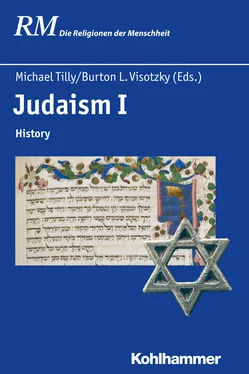For further reading
Judaism in Babylonia: 226–650 CE
Geoffrey Herman
1 Jewish settlement, community, and daily life
2 Under the Arsacid and Sasanian Empires
3 Jews and Persians
4 The Babylonian Legacy
5 Rabbis and Rabbinic Schools
6 The Exilarchate
For further reading
Jews and/under Islam: 650–1000 CE
Phillip Issac Liebermann
1 General Conditions
2 The Pact of ʿUmar
3 Communal Organization
4 Daily Life
5 The Karaite Schism
6 Religious Life
7 Regional Life
For further reading
Judaism in the Middle Ages: 1000–1500
Robert Chazan
1 Introduction
2 Northern Europe Jewry: Beginnings
3 Northern European Jewry: Maturation
4 Northern European Jewry: Accelerating Pressures
5 Southern European Jewry
6 Conclusions
For further reading
Judaism During and After the Expulsions: 1492–1750
Joseph M. Davis
1 The »Early Modern« Period
2 The Catastrophe: Expulsion from Spain
3 The Recovery of Judaism 1492–1618
4 Early Modern Judaism
4.1 The Formation of Early Modern Judaism
4.2 Printing and Literacy
4.3 Kabbalah
5 The Seventeenth Century
5.1 The Jews in the Global Crisis of the Seventeenth Century (1618–1676)
5.2 The Spiritual Crisis of the Mid-Seventeenth Century: Baruch Spinoza and Shabbetai Tsvi
5.3 New Centers and New Peripheries 1675–1750
6 Hasidism and its Opponents: 1740–the Present
For further reading
Modern Judaism: 1750–1930
Dominique Bourel
1 When did »Modern Judaism« begin?
2 Moses Mendelssohn and the Jewish Enlightenment (
3 Jewish Enlightenment in Europe
4 The Birth and Solidification of Hasidism
5
6
7 The Debate between Orthodoxy and Reform
8 Modern American Judaism
9 The Emergence of Zionism
For further reading
The Holocaust and Anti-Semitism
Michael Berenbaum
1 The Rise of the Nazi Movement
1.1 Adolf Hitler—Evolution of an Anti-Semite
1.2 Roots of Anti-Semitism
1.3 Nazi Rise to Power
1.4 The Fragility of Democracy
1.5 Nazis in Power
1.6 German Jewish Reaction
1.7 The 1936 Olympics
2 1938—The End of the Beginning and the Beginning of the End
2.1 The »Anschluss« of Austria
2.2 Evian and the Refugee Crisis
2.3 The Kristallnacht Reich’s Pogrom, the Night of Broken Glass
2.4 The American Reaction
3 The Beginning of World War II
3.1 German Conquests
3.2 The Ghettos
3.3 Resistance in the Ghettos
3.4 Jewish Life in Western Europe
3.5 Theresienstadt
4 The Final Solution
4.1 The Killers
4.2 Situation in the Baltics
4.3 The Wannsee Conference
4.4 »Liquidation« of the Ghettos
4.5 Deportation by Rail
4.6 Death Camps
4.7 Death Marches
5 The Aftermath of World War II
5.1 Liberation
5.2 Return to Life
5.3 Nuremberg Trials
5.4 Genocide: The Word and the Crime
6 Anti-Semitism after World War II
6.1 Eroding the Foundations of Christian Anti-Semitism
The Catholic Church
The Protestant Churches
6.2 Jewish Life in Israel
6.3 Anti-Semitism in North America
6.4 Anti-Semitism in Europe
Eastern Europe
7 Survivors and Memory
7.1 Survival and Survivors
7.2 Holocaust Memory in the Contemporary World
For further reading
Zionism and the State of Israel
Martin Kloke
1 »By the Rivers of Babylon«: The Early History of Zionism
2 Jewish Palestine before the First World War
3 The First World War and the Balfour Declaration, 1917
4 Consolidation and Advances: The Zionist Project under the British Mandate
5 In the Shadow of the Shoah: Jewish Mass Immigration, the Arab Uprising and, the Second World War
6 Partition Plans in Context: En Route to the State of Israel
7 War and Terrorism: Signs of a Violent Relationship between Israel and Palestine
8 The Founding of the State of Israel
9 Foundations of State and Society
10 The Israelis: A Migrant Society in Flux
11 Israel in the Middle East: Between War and Peace-Process
12 Democracy under Stress
13 The Israeli Economic Miracle and the Nuclear Nightmare
14 Israel’s Image in the World
15 Future Prospects: Looking Ahead
For further reading
Judaism in America
Deborah Dash Moore
1 A Revolution in American Judaism
2 Conflict and Competition
3 Americanizing Jewish Culture: Capitalism and Gender
4 Jewish Communal Organizations
5 New Religious Movements
6 Postwar Religion and Politics
7 American Jews with American Values
8 Diversity and Dissent
For further reading
Judaism in Europe after the Second World War
Kerstin Armborst-Weihs
1 Displaced Persons
2 The Soviet Union and Successor States
2.1 The Situation of the Jewish Population in the Post-War Decades
2.2 Jewish Emigration from the Soviet Union
2.3 Developments since
3 Poland and Hungary
4 Germany
5 Great Britain
6 France
7 Southern Europe
7.1 Italy
7.2 Spain
7.3 Greece
8 Judaism in Europe: Organizations, Plans, and Discussions
For further reading
Index
1 Sources
1 Hebrew Bible
Genesis
Numbers
Deuteronomy
Judges
2 Kings
Ezra
Nehemiah
Isaiah
Jeremiah
Ezekiel
Daniel
Hosea
1.1 New Testament
1.2 Deuterocanonical Works and Septuagint
1.3 Old Testament Pseudepigrapha
1.4 Dead Sea Scrolls
1.5 Philo of Alexandria
1.6 Flavius Josephus
1.7 Rabbinical Sources
1.8 Classical and Ancient Christian Writings
2 Names
3 Keywords
Maps
Burton L. VisotzkyMichael Tilly
In the beginning, the Hebrew Bible was formed as an anthology of Jewish texts, each shaping an aspect of Jewish identity. As the Israelite community and its various tribes became two parts: a Diaspora and its complement, the community in the Land of Israel—competing interests formed a canon that represented their various concerns. Over time, the communities grew, interacted, and focused on local religious needs, all the while ostensibly proclaiming fealty to the Jerusalem Temple. Even so, some communities rejected the central shrine that the Torah’s book of Deuteronomy proclaimed to be »the place where the Lord chose for His name to dwell« (Deut. 12:5, et passim). Still other Jewish communities had their own competing shrines. Yet for all their dissentions, disagreements, and local politics, there was a common yet unarticulated core of beliefs and practices that unified the early Jewish communities across the ancient world. 1As the most important prerequisites and foundations of all areas of their lives—and irrespective of all pluriformity or heterogeneity—strict monotheism and the central importance of the Torah, which was considered to be directly inspired by God, shaped the contours of what can be perceived in manifold forms as »Judaism«. As the Second Temple period (516 BCE—70 CE) drew to a close, the biblical canon took its final shape, and a world-wide Jewish community emerged as a moral and spiritual power. 2
That canon, by definition, excluded certain Jewish texts, even as it codified others. And the political processes of the Persian and Hellenistic empires confined and defined the polities of their local Jews. From east to west, at the very moment in 70 CE when the centralized Jerusalem cult was reduced to ashes, Judaism, like the mythical phoenix, emerged. Across the oikumene, with each locale finding its own expressions, communities that had formed around the study of the biblical canon produced commentaries, codes, chronicles, commemorations, and compendia about Judaism. Some of these were inscribed on stone, others on parchment and paper, while still others were committed to memory. The devotion to this varied literature helped shape a Jewish culture and history that has persisted for two millennia.
Читать дальше







